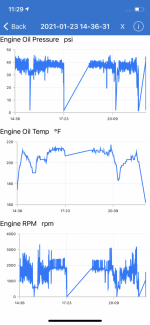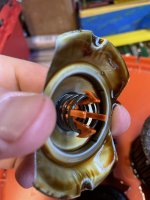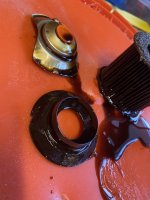Sounds like you may have solved the problem. 
You are using an out of date browser. It may not display this or other websites correctly.
You should upgrade or use an alternative browser.
You should upgrade or use an alternative browser.
Why does a UPF48r filter result in more engine oil pressure than a PF48e?
- Thread starter russellbailey
- Start date
russellbailey
Thread starter
It does appear that I have fixed the low oil pressure problem with the filter.
And thank you to all for the information on how the oiling system works - that is all new to me and really interesting. This is a great web group.
I am going to monitor it as the oil wears back to the 60% it was on the 48e
I’ve got 2 more images - the ELM app
logs the parameters over time,
and here are comparisons of the 48e with 60% oil life and the upf48r with about 85% oil life. You can see how much higher the pressure is now. These images are not the same length - one is about 3 hrs and one about 5hrs.
And thank you to all for the information on how the oiling system works - that is all new to me and really interesting. This is a great web group.
I am going to monitor it as the oil wears back to the 60% it was on the 48e
I’ve got 2 more images - the ELM app
logs the parameters over time,
and here are comparisons of the 48e with 60% oil life and the upf48r with about 85% oil life. You can see how much higher the pressure is now. These images are not the same length - one is about 3 hrs and one about 5hrs.
Attachments
4WD
$50 site donor 2024
Going to cut open the suspect filter ?It does appear that I have fixed the low oil pressure problem with the filter.
And thank you to all for the information on how the oiling system works - that is all new to me and really interesting. This is a great web group.
I am going to monitor it as the oil wears back to the 60% it was on the 48e
I’ve got 2 more images - the ELM app
logs the parameters over time,
and here are comparisons of the 48e with 60% oil life and the upf48r with about 85% oil life. You can see how much higher the pressure is now. These images are not the same length - one is about 3 hrs and one about 5hrs.
russellbailey
Thread starter
I can.Going to cut open the suspect filter ?
What am I looking for? And any suggestion on how to cut it open?
The upf48r is maybe $14 versus $6 for the pf48e. If $8 a filter for 4 filters a year will get more useful life out of the engine, that is a deal.
Last edited:
4WD
$50 site donor 2024
I have an actual filter cutter but some guys use the old style can opener, dremel tool, grinder etcI can.
What am I looking for? And any suggestion on how to cut it open?
The upf48r is maybe $14 versus $6 for the pf48e. If $8 a filter for 4 filters a year will get more useful life out of the engine, that is a deal.
Just looking for a restriction
I personally think your oil pressure problem is because of the “E” core filter design. The PF48E is an E Core filter and I think this design is more restrictive than other filters.
The UPF48 is not an E core filter and I think has the same internals as a Mobil 1 filter.
A while back, A dealer put a PF-61E oil filter on my 1999 Deville. Sometimes the oil light would flicker at idle.
I switched back to the classic PF-61 design (they were still selling them back then) and never saw the oil light flicker again. I had the car another 6 years after that and still never saw the oil light flicker
The UPF48 is not an E core filter and I think has the same internals as a Mobil 1 filter.
A while back, A dealer put a PF-61E oil filter on my 1999 Deville. Sometimes the oil light would flicker at idle.
I switched back to the classic PF-61 design (they were still selling them back then) and never saw the oil light flicker again. I had the car another 6 years after that and still never saw the oil light flicker
As an aside, your first graph showed a very strong correlation of oil temperature with rpm, something that is well known but difficult to measure without an oil temperature read out. Thanks for that.It does appear that I have fixed the low oil pressure problem with the filter.
And thank you to all for the information on how the oiling system works - that is all new to me and really interesting. This is a great web group.
I am going to monitor it as the oil wears back to the 60% it was on the 48e
I’ve got 2 more images - the ELM app
logs the parameters over time,
and here are comparisons of the 48e with 60% oil life and the upf48r with about 85% oil life. You can see how much higher the pressure is now. These images are not the same length - one is about 3 hrs and one about 5hrs.
4WD
$50 site donor 2024
What part of an eCore do you see as restrictive … ? I have a few PF63E filters left but was disappointed to see a similar filter leak at the seam (bubble point test) … so may ditch them …I personally think your oil pressure problem is because of the “E” core filter design. The PF48E is an E Core filter and I think this design is more restrictive than other filters.
The UPF48 is not an E core filter and I think has the same internals as a Mobil 1 filter.
A while back, A dealer put a PF-61E oil filter on my 1999 Deville. Sometimes the oil light would flicker at idle.
I switched back to the classic PF-61 design (they were still selling them back then) and never saw the oil light flicker again. I had the car another 6 years after that and still never saw the oil light flicker
plus they have updated the E-Core design throughout it's lifetime...I believe you may find that both the UPF Delco filters as well as the Mobil 1 filters have also gone through some changes within the last year...
Bill
Bill
russellbailey
Thread starter
I noticed that also.As an aside, your first graph showed a very strong correlation of oil temperature with rpm, something that is well known but difficult to measure without an oil temperature read out. Thanks for that.
That data set was driving through substantial mountains in West Virginia where my engine rpm was over 2000 a good bit - air temp was anywhere from 30 F to 10 F. The pf48e data set with a flat oil temperature was slower driving over less steep hills with an air temp of more like 25-30 F all the way.
It certainly isn't the eCore center tube. If true, It can only be the media, which would mean the media would have to be different than the non-eCore variation.
4WD
$50 site donor 2024
Right … and having cut open both types in AC Delco … seems very similarIt certainly isn't the eCore center tube. If true, It can only be the media, which would mean the media would have to be different than the non-eCore variation.
One thing I have wondered about in the e-core design is the extremely limited clearance between the media and the side of the can. The felt/synthetic end caps have these little nubs that act as spacers. They are very small and don’t instill a lot of confidence. I had always hypothesized that perhaps this very narrow clearance between media and can could act in a restrictive manner. And in this regard it would seem that the bypass valve would provide no real remedy.
Based on recent anecdotal accounts, and my own verification that the UPF48R is still a high quality Champion filter (it has NOT changed as the Mobil 1 has), and the fact that I am towing now, I have reverted to using that.One thing I have wondered about in the e-core design is the extremely limited clearance between the media and the side of the can. The felt/synthetic end caps have these little nubs that act as spacers. They are very small and don’t instill a lot of confidence. I had always hypothesized that perhaps this very narrow clearance between media and can could act in a restrictive manner. And in this regard it would seem that the bypass valve would provide no real remedy.
Hard to tell unless you do some calculations of the flow area between the media and can. I'm betting filter designers look at that design parameter. If it does cause more flow resistance, it just shows up as a few PSI more delta-p across the filter - and the PD oil pump will still force it through. Go watch the videos in this thread if you haven't already. There spread difference in all those tested filters wasn't much when the oil is hot.One thing I have wondered about in the e-core design is the extremely limited clearance between the media and the side of the can. The felt/synthetic end caps have these little nubs that act as spacers. They are very small and don’t instill a lot of confidence. I had always hypothesized that perhaps this very narrow clearance between media and can could act in a restrictive manner. And in this regard it would seem that the bypass valve would provide no real remedy.
Would you all like to see ISO 4548-12 Oil Filter Lab Testing Comparison, Efficiency & Capacity, Pressure vs Flow, Bubble Point, and Burst?
I am thinking about running lab tests for an OEM and four aftermarket filters for testing for a Chevy truck. This testing will include ISO 4548-12 multi-pass efficiency and capacity, pressure vs flow hot and cold simulation curves, bubble point/largest pore size, and a collapse/burst test. I...
bobistheoilguy.com
I have no explanation why, but it certainly seems like the e-core AC filters are somehow restricting flow. This isn't the first time this issue has surfaced; more than 1 person reported seeing it in this thread: https://bobistheoilguy.com/forums/threads/5-3-6-0-gm-trucks-losing-oil-pressure-pf48e.286907/ . Also, GM itself acknowledges the issue in the TSB.
russellbailey
Thread starter
So, I cut the filter open. What am I looking for?
Links to 2 videos as I apparently can only upload pictures here.
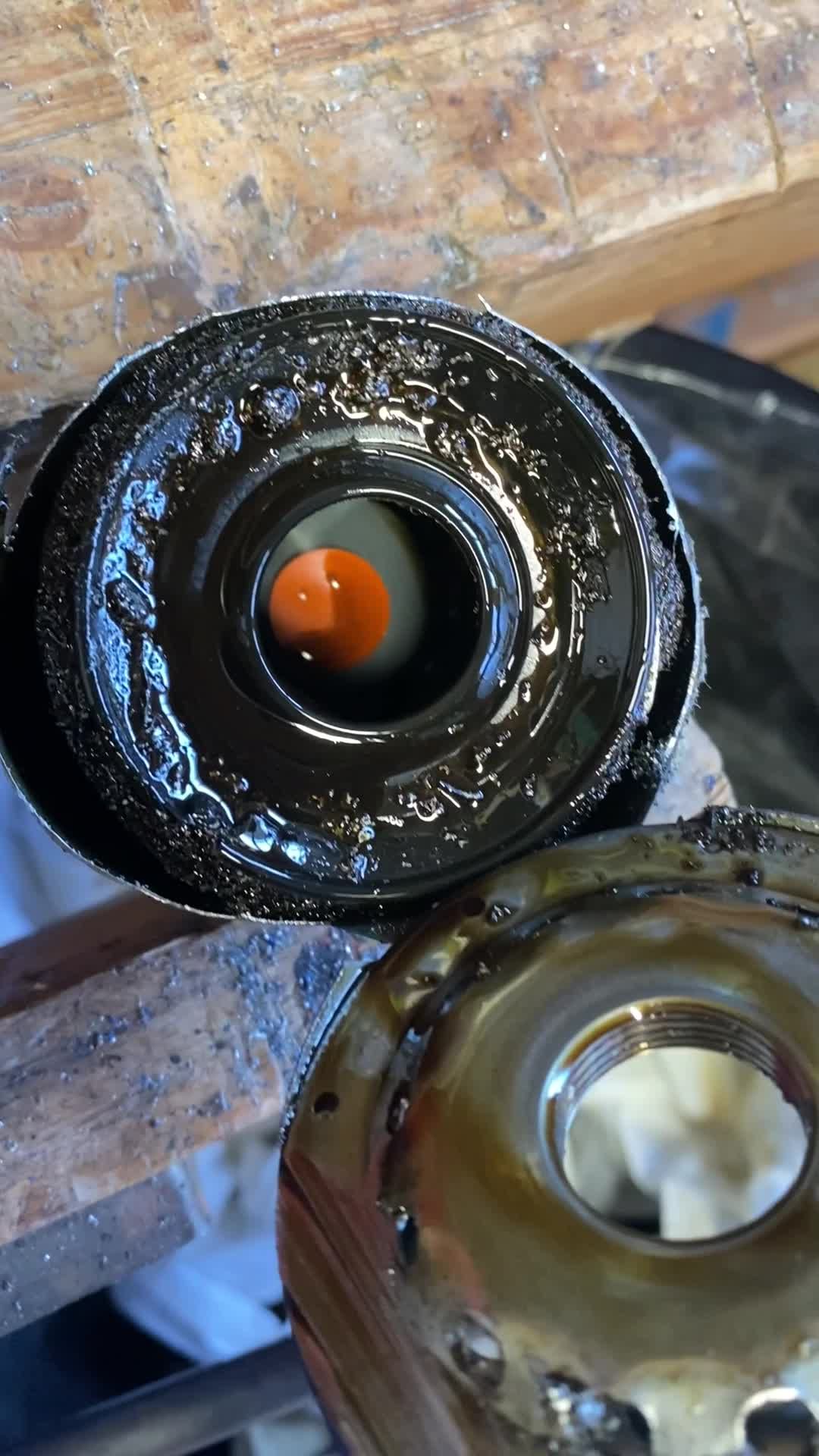
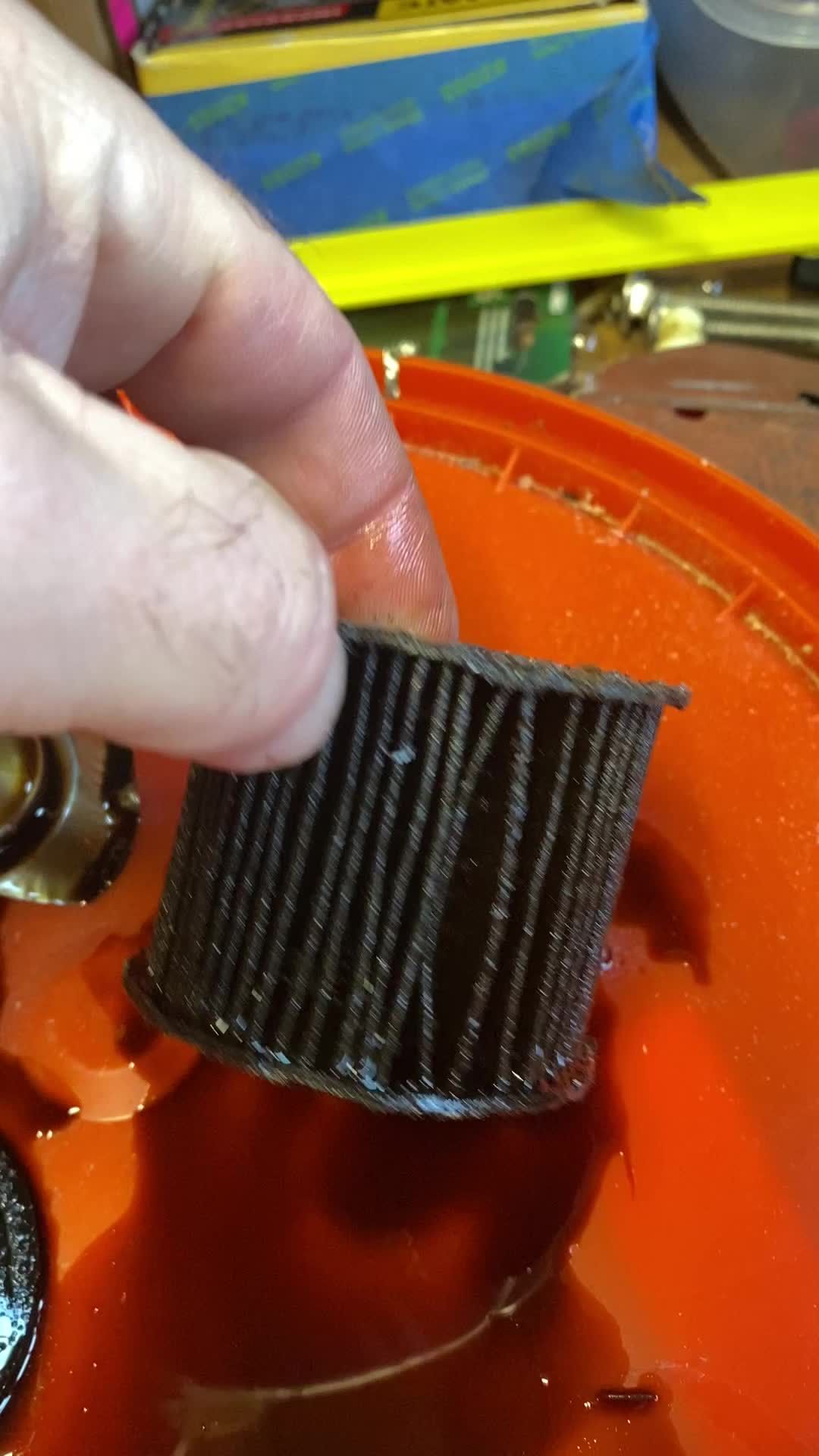
Links to 2 videos as I apparently can only upload pictures here.
Attachments
4WD
$50 site donor 2024
Interesting … so I had this used PF63E … 5k in a clean engine that ran M1 AP no more than 7kOne thing I have wondered about in the e-core design is the extremely limited clearance between the media and the side of the can. The felt/synthetic end caps have these little nubs that act as spacers. They are very small and don’t instill a lot of confidence. I had always hypothesized that perhaps this very narrow clearance between media and can could act in a restrictive manner. And in this regard it would seem that the bypass valve would provide no real remedy.
(added new Fram Ultra XG10575 equivalent)
Last edited:
Look how close the sides of the element are to the can. I'm sure it works okay, but it seems like in the right circumstances it would limit flow...but that is obviously just speculation.
Similar threads
- Replies
- 21
- Views
- 1K
- Replies
- 39
- Views
- 2K
- Replies
- 4
- Views
- 1K

